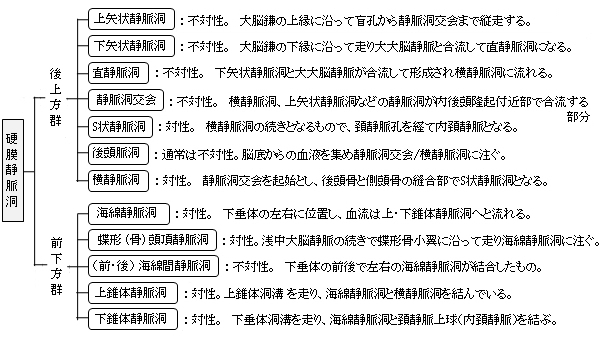
・「 they increase in size as they proceed, from back to center」( Wikipedia )


「 日本人体解剖学 」には以下のような解説文が見られる。
「 上矢状静脈洞、直静脈洞、後頭静脈洞および上錐体静脈洞と連絡するほかに、大脳の静脈と板間静脈の一部、ときに迷路静脈も受ける。また、乳突導出静脈で後頭静脈と、顆導出静脈で椎骨静脈叢と連絡する。 」
また、以下は「 船戸和弥のHP 」の解説文の一部となる。
「 横静脈洞には上錐体静脈洞、下大脳静脈、下小脳静脈、板間静脈などが注ぐ。」

「 Wikipedia 」には以下のような解説文が見られる。
「 The transverse sinuses are of large size and begin at the internal occipital protuberance; one, generally the right, being the direct continuation of the superior sagittal sinus, the other of the straight sinus. 」
以下は静脈洞交会から内頚静脈までの静脈洞を簡単に表した図となる。

以下は「 船戸和弥のHP 」をベースにして作成した硬膜静脈洞の一覧となる。資料によってそれぞれのグループに属する静脈洞には若干の違いが見られる。

以下は「 Wikipedia 」の解説文となる。
「 The transverse sinuses ( left and right lateral sinuses ), within the human head, are two areas beneath the brain which allow blood to drain from the back of the head. They run laterally in a groove along the interior surface of the occipital bone. They drain from the confluence of sinuses ( by the internal occipital protuberance ) to the sigmoid sinuses, which ultimately connect to the the internal jugular vein.
. See diagram (at right): labeled under the brain as "sin. trans." (for Latin: sinus transversus).
The transverse sinuses are of large size and begin at the internal occipital protuberance; one, generally the right, being the direct continuation of the superior sagittal sinus, the other of the straight sinus.
【 語 句 】
・groove :溝 ・ occipital bone:後頭骨 ・ confluence of sinuses:静脈洞交会 ・ internal occipital protuberance:内後頭隆起 ・ sigmoid sinuses:S状静脈洞 ・internal jugular vein :内頚静脈 ・ superior sagittal sinus:上矢状静脈洞 ・ straight sinus:直静脈洞
Each transverse sinus passes lateralward and forward, describing a slight curve with its convexity upward, to the base of the petrous portion of the temporal bone, and lies, in this part of its course, in the attached margin of the tentorium cerebelli ; it then leaves the tentorium and curves downward and medialward ( an area sometimes referred to as the sigmoid sinus ) to reach the jugular foramen, where it ends in the internal jugular vein.
In its course it rests upon the squama of the occipital, the mastoid angle of the parietal, the mastoid part of the temporal, and, just before its termination, the jugular process of the occipital; the portion which occupies the groove on the mastoid part of the temporal is sometimes termed the sigmoid sinus.
【 語 句 】
・ petrous portion:錐体部 ・ temporal bone:側頭骨 ・ tentorium cerebelli:小脳テント
・jugular foramen :頚静脈孔 ・ squama of the occipital : = occipital squama? 後頭鱗 ・mastoid angle :乳突角 ・ parietal:頭頂骨 ・ mastoid part:乳突部 ・ jugular process:頚静脈突起
The transverse sinuses are frequently of unequal size, with the one formed by the superior sagittal sinus being the larger; they increase in size as they proceed, from back to center.
On transverse section, the horizontal portion exhibits a prismatic form, the curved portion has a semicylindrical form.
They receive the blood from the superior petrosal sinuses at the base of the petrous portion of the temporal bone; they communicate with the veins of the pericranium by means of the mastoid and condyloid emissary veins ; and they receive some of the inferior cerebral and inferior cerebellar veins, and some veins from the diploë.
The petrosquamous sinus, when present, runs backward along the junction of the squama and petrous portion of the temporal, and opens into the transverse sinus.」
【 語 句 】
・ prismatic : プリズム状の ・ semicylindrical : マボコ状の ・ superior petrosal sinuses : 上錐体静脈洞 ・ pericranium : 頭蓋骨膜 ・ mastoid and condyloid emissary veins : 乳突導出静脈と顆導出静脈 ・ inferior cerebral vein : 下大脳静脈 ・ inferior cerebellar veins : 下小脳静脈 ・ diploë : 板間層 ・ petrosquamous sinus : 側頭錐体鱗部静脈洞
【 イラスト掲載サイト 】
・ イラストや写真を掲載しているサイト-Ⅰ
・ イラストや写真を掲載しているサイト-Ⅱ
・ イラストや写真を掲載しているサイト-Ⅲ
・ イラストや写真を掲載しているサイト-Ⅳ
・ イラストや写真を掲載しているサイト-Ⅴ

|